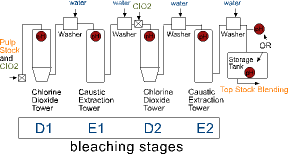
Bleaching is a whitening process that is used in the paper industry to produce paper with high brightness. Chemicals - such as chlorine gas (C), sodium hypochlorite (H), oxygen (O), hydrogen peroxide (X), ozone (Z), and chlorine dioxide (D) - are used in various combinations to produce pulp with the desired properties. Recent limitations on the use of chlorine (and hypochlorite) have resulted in more extensive use of chlorine dioxide as an alternate bleaching chemical. Chlorine dioxide bleaching is referred to as elemental chlorine free (ECF) and is the process used in over 50% of US mills. (Letters in brackets are a labelling convention - and not chemical symbols)
The process
The chlorine dioxide is mixed with the pulp and contacted in each D (chlorine dioxide) tower (see Figure 1) for about 1 hour per stage. The primary purpose of bleaching is to maximise removal of the lignin binding agents in the pulp without degradation of carbohydrates, which weakens the final product (paper). The pH is maintained at relatively low levels (around 4) to foster rapid chemical reaction. Higher pH levels require more chlorine dioxide for equivalent bleaching action.

Following bleaching in each D tower, the reacted lignin is removed by dissolving the lignin under high pH conditions (typically over 11). Lower pH levels will not dissolve all of the lignin. This caustic extraction (E) stage is preceded by a washing step to reclaim the chlorine dioxide and to minimise carryover of the acidic chemicals. The amount of caustic needed is proportional to the amount of bleach added in the D stage.
Bleach plant sequences vary widely from mill to mill; however, the D-E-D-E stage sequence is quite common. At least two bleaching stages are generally required to produce the specified brightness, with additional stages for more specialised uses. Consistency (% solids) is typically maintained at a high level (up to 10%) to minimise water use. Temperature is controlled around 60°C, and doses of 5% chlorine dioxide are common.
Measurements
pH is measured in the D tower to control the bleaching reaction conditions. pH is also measured in the E stages to control addition of the caustic used for extraction. ORP can be used in the washer between the D and E stages to verify that rinsing of the chlorine dioxide has been completed. Attempts to use ORP to control chlorine dioxide dosage in the D tower have been mostly unsuccessful due to the non-linear character of ORP.
pH measurements in the D and E stages have historically been among the most difficult applications in the pulp mill. The high pulp consistency of the process stream and harsh bleaching chemicals degrade the performance of most general-purpose sensors. Those sensors tend to require cleaning regularly and frequently, and they may not be able to withstand the strongly oxidising environment.
Rosemount Instruments
The TUpH Model 398R pH and ORP sensors are well suited for this kind of application. The wide-area junction provides resistance to coating, while the helical pathway prevents process intrusion into the inner reference chamber. Construction materials of Tefzel and Kalrez are used to withstand the strongly oxidising environment.
Models 54e pH/ORP and 3081 pH/ORP are suitable instruments for monitoring and controlling pH and ORP in pulp and paper mills. All configuration and calibration can be conducted remotely using the HART protocol and Emerson Process Management's AMS PC interface. The combination of the Model 398R with either the AC-powered Model 54e or the DC-powered Model 3081 provides ease of installation, ease of operation, and the low maintenance requirements.
Rosemount TUpH model 398R retractable pH/ORP sensor:
* Titanium and Tefzel construction with choice of Kalrez or Viton seals allows sensor to be tailored to individual process needs.
* Stands up to chlorine dioxide in pulp bleaching towers.
* Retractable design allows sensor to be removed for calibration and maintenance without process shutdown.
* TUpH reference technology ensures long life in processes that coat.
Rosemount model 3081 pH/ORP remote controlled HART SMART two-wire transmitter:
* Remote communication is simple; use the handheld infrared remote controller or any HART compatible device.
* Comprehensive pH glass diagnostics to warn user of the need for calibration, maintenance or sensor replacement.
* Automatic calibration with buffer recognition and stabilisation check.
* Robust NEMA 4X enclosure protects the transmitter from harsh mill environments.
* Non-volatile EEPROM memory retains program settings and calibration data during power failures.
Rosemount model 54E pH/ORP SMART analyser:
* Comprehensive pH glass diagnostics to warn user of the need for calibration, maintenance or sensor replacement.
* Heavy duty NEMA 4X (IP65) enclosure of epoxy-painted aluminium.
* Fully descriptive diagnostic messages and easy-to-use interface for operation in English, French, German, Italian, or Spanish.
* Automatic calibration with buffer recognition and stabilisation check.
* Two independent outputs for primary variable and temperature.
* Three alarms with programmable logic plus one dedicated fault alarm.
For more information contact Luculle Stols, Alpret Control Specialists, 011 249 6700, [email protected], www.alpret.co.za
| Tel: | +27 11 249 6700 |
| Email: | [email protected] |
| www: | www.acs-autocon.com |
| Articles: | More information and articles about Automation Control Solutions |

© Technews Publishing (Pty) Ltd | All Rights Reserved